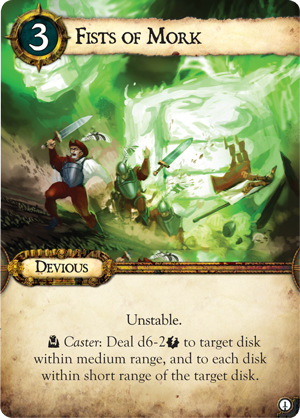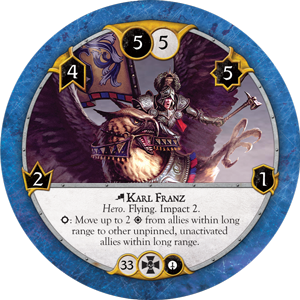Nuevo avance de FFG, sobre el juego de batallas tácticas, en curiosos discos, ambientado en el universo de Warhammer Fantasy, Diskwars.
En esta nueva preview, veremos como funciona, uno de los apartados más importantes del juego, el combate.
“Most armies will have a unit or two of archers, crossbowmen or mighty war machines, and use these missile units to thin the enemy ranks before the bloody press of melee begins.”
–Warhammer
–Warhammer
Our last preview of the fast-paced battles of Warhammer: Diskwars focused on the game’s melee combat. Today, we focus on the game’s rules for ranged combat, as well as a number of the different abilities that disks may gain via keywords. Together, these elements add tremendous depth to the game’s battles, permitting a great deal of tactical flexibility, and immersing you in the fantasy and chaos of warfare in the Old World.

A Maiden Guard launches a ranged attack against a Kurgan Marauder
Ranged Attacks
We already touched upon ranged attacks in the game’s description page and in our review of the four basic actions available to disks during the Activation Phase. Still, understanding how ranged attacks function within the game will prove crucial to your success as a battlefield commander, and there’s a lot of material left to cover!
For starters, while each unit capable of making a ranged attack comes with the ranged icon ( ), it also comes with more information about the attack.
), it also comes with more information about the attack.
Range
First of all, all units with ranged attacks will indicate the maximum range at which they can fire their shots: short, medium, long, or siege. Short, medium, and long range all correspond to segments of the game’s range ruler. A unit with a “siege” ranged attack can fire across the battlefield at any distance!

To measure your shot, you set the range ruler against the edge of your disk and check whether or not your target’s edge falls within the appropriate range band. You can measure range whenever you want, and when you activate your disk, if your target is close enough, you can fire.
Dice Pool
In Warhammer: Diskwars, you make ranged attacks by rolling a number of custom battle dice. Accordingly, each unit with a ranged attack will indicate its “missile value,” with a number of dice icons equal to the number of battle dice it gets to roll when it makes its ranged attack.

The six sides of the Warhammer: Diskwars battle dice.
There are five possible results on each battle die, and you resolve all dice results independently.
- Scatter (
 ): When you roll a scatter result, you reroll that battle die against the closest of any disks within short range of the original target. On the rerolled die, you ignore scatter results, but apply any other results as normal. (Yes, scatter results may cause you to target your own units with friendly fire!)
): When you roll a scatter result, you reroll that battle die against the closest of any disks within short range of the original target. On the rerolled die, you ignore scatter results, but apply any other results as normal. (Yes, scatter results may cause you to target your own units with friendly fire!) - Hit (
 ): When you roll a hit, you apply your unit’s ranged damage to your target. Hit results are ignored whenever you make an attack at siege range.
): When you roll a hit, you apply your unit’s ranged damage to your target. Hit results are ignored whenever you make an attack at siege range. - Critical Hit (
 ): When you roll a critical hit, you apply your unit’s ranged damage to your target. Additionally, if the target disk has not yet been activated, you can place an activation token on it.
): When you roll a critical hit, you apply your unit’s ranged damage to your target. Additionally, if the target disk has not yet been activated, you can place an activation token on it. - Miss (
 ): Any battle die with a miss result has no effect.
): Any battle die with a miss result has no effect. - Chaos (
 ): The Chaos result doesn’t have any effect unless the disk with which you initiate your ranged attack has an ability triggered by the
): The Chaos result doesn’t have any effect unless the disk with which you initiate your ranged attack has an ability triggered by the  icon.
icon.
As you can see, the game’s custom battle dice introduce far more potential to ranged combat than a binary “hit-or-miss” system. The wider range of potential results adds to your tactical considerations and further immerses you in the chaos and turbulence of a world ravaged by unending war.
Attack Strength
In addition to its maximum range and dice pool, each unit with a ranged attack indicates the strength of its attack, as well as the type of damage it deals.
|
- A unit’s ranged attack strength is the amount of damage it deals with every hit or critical hit result.
- In Warhammer: Diskwars, there are two types of damage: physical (
 ) and arcane (
) and arcane ( ). Though both types function similarly, some units have resistance – or even complete immunity – to one type or the other.
). Though both types function similarly, some units have resistance – or even complete immunity – to one type or the other.
Units with ranged attacks are a vital part of any army. They get to fire before melee combat is resolved, they can potentially shut down enemy disks before they ever get to act, and they extend your effective footprint on the battlefield. As muskets blare and magical fire rips through the air, you’ll need to figure out how to make the best possible use of your ranged attacks in order to conquer the Old World.
Keyword Abilities
Thirteen different keywords appear on the disks in theWarhammer: Diskwars Core Set, and they all introduce special abilities that differentiate the game’s units and allow players to design and develop highly focused armies and strategies.
Many of these keywords, like Frenzy and Relentless, allow the disks that possess them to break some of the game’s basic rules. For example, any disk with Frenzy is able to attack all the disks it pins, not just one, and disks that have the Relentless keyword may choose to continue moving even after their movement would cause them to pin an enemy unit.
Other keywords, like Impact X and Resistant (X), serve as shorthand for additional rules utilized by a number of different units. Any disk with the Impact X keyword deals physical damage equal to its impact value to each disk it pins after a flip. Like ranged damage, impact damage is dealt during the Activation Phase and may allow you to eliminate enemy units before they activate or deal melee damage. On the other hand, units with Resistant (X) take only half damage (rounded up) from the indicated source.
 Of course, because the battles of Warhammer: Diskwars take place amid the chaos and turmoil of the Old World, the game needs to account for the powerful magic harnessed by the Empire’s wizards, Chaos daemons, High Elves and others. One of the ways the game brings magic into play is through the Magic (X)keyword, which allows a disk to deal arcane damage to any target within medium range. This powerful ability doesn’t require a ranged attack roll; instead, it’s a focus ability, and disks with Magic (X) are some of the most potent and important units in the game.
Of course, because the battles of Warhammer: Diskwars take place amid the chaos and turmoil of the Old World, the game needs to account for the powerful magic harnessed by the Empire’s wizards, Chaos daemons, High Elves and others. One of the ways the game brings magic into play is through the Magic (X)keyword, which allows a disk to deal arcane damage to any target within medium range. This powerful ability doesn’t require a ranged attack roll; instead, it’s a focus ability, and disks with Magic (X) are some of the most potent and important units in the game.
Additionally, many of the units that share the Magic (X) keyword also possess theCaster trait. While traits don’t have any inherent abilities, they serve as references for other abilities and help further distinguish units like the Bright Wizard. For example, the Fists of Mork command card allows a Caster to unleash powerful magic against his foes.
All together, the game’s keyword abilities and traits, combined with the unique abilities that some disks possess, differentiate the game’s disks and give them flavor. When you see Grom the Paunch rolling along the battlefield, you know that his combination of Impact 3 and Relentless make this Orc Hero a terrible threat to any enemy units within five flips!

Though Karl Franz doesn’t have quite the same physical impact as Grom the Paunch, his Flying keyword allows him to ignore all disks and terrain during his movement, and his unique focus ability can help any shrewd commander capitalize upon even the slightest of any opponent’s missteps.

Disk Abilities and Your Battle Plan
Your disks’ keywords, special abilities, and ranged attacks may provide you the tools you need to dominate the field of battle, but you’ll need more than mere tools. The battles of Warhammer: Diskwars are ferocious and chaotic, and if you don’t want to be annihilated, you’ll need to learn how to read your enemies movements and how to use the battlefield to your advantage.
In our next preview, then, we’ll look at the choices that you make during scenario setup, including the ways that the terrain you choose can change an entire battle plan!



















0 comentarios :
Dí lo que piensas...